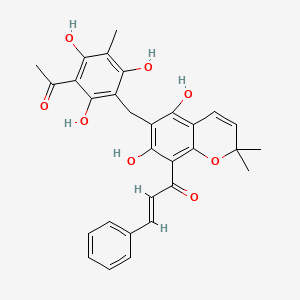| MeSH term | MeSH ID | Detail |
|---|---|---|
| Diabetes Mellitus, Type 2 | D003924 | 87 associated lipids |
| Glioma | D005910 | 112 associated lipids |
| Prostatic Neoplasms | D011471 | 126 associated lipids |
| Cell Transformation, Neoplastic | D002471 | 126 associated lipids |
| Edema | D004487 | 152 associated lipids |
| Colonic Neoplasms | D003110 | 161 associated lipids |
| Adenocarcinoma | D000230 | 166 associated lipids |
| Lung Neoplasms | D008175 | 171 associated lipids |
| Body Weight | D001835 | 333 associated lipids |
rottlerin
Rottlerin is a lipid of Polyketides (PK) class. Rottlerin is associated with abnormalities such as PARAGANGLIOMAS 2, Hyperostosis, Diffuse Idiopathic Skeletal, Virus Diseases, Perisylvian syndrome and Autoimmune disease (systemic) NOS. The involved functions are known as Apoptosis, Regulation, Signal Transduction, inhibitors and Proteasome Inhibitors [MoA]. Rottlerin often locates in Clone, Membrane, Body tissue, Plasma membrane and soluble. The associated genes with Rottlerin are XIAP gene, GAPDH gene, ICAM1 gene, P4HTM gene and TNFSF10 gene. The related lipids are Promega, Fatty Acids, Sphingolipids, Lipopolysaccharides and Saponin. The related experimental models are Mouse Model, Xenograft Model and Cancer Model.
Cross Reference
Introduction
To understand associated biological information of rottlerin, we collected biological information of abnormalities, associated pathways, cellular/molecular locations, biological functions, related genes/proteins, lipids and common seen animal/experimental models with organized paragraphs from literatures.
What diseases are associated with rottlerin?
rottlerin is suspected in Infection, Morphologically altered structure, Ischemia, Pulmonary Edema, Asthma, Cardiovascular Diseases and other diseases in descending order of the highest number of associated sentences.
Related references are mostly published in these journals:
- J. Biol. Chem. (5)
- Am. J. Physiol. Heart Circ. Physiol. (3)
- Am. J. Physiol. Lung Cell Mol. Physiol. (3)
- Others (19)
| Disease | Cross reference | Weighted score | Related literature |
|---|
Possible diseases from mapped MeSH terms on references
We collected disease MeSH terms mapped to the references associated with rottlerin
PubChem Associated disorders and diseases
What pathways are associated with rottlerin
There are no associated biomedical information in the current reference collection.
PubChem Biomolecular Interactions and Pathways
Link to PubChem Biomolecular Interactions and PathwaysWhat cellular locations are associated with rottlerin?
Visualization in cellular structure
Associated locations are in red color. Not associated locations are in black.
Related references are published most in these journals:
| Location | Cross reference | Weighted score | Related literatures |
|---|
What functions are associated with rottlerin?
Related references are published most in these journals:
| Function | Cross reference | Weighted score | Related literatures |
|---|
What lipids are associated with rottlerin?
Related references are published most in these journals:
- J. Biol. Chem. (5)
- Am. J. Physiol. Heart Circ. Physiol. (1)
- Appl. Environ. Microbiol. (1)
- Others (10)
| Lipid concept | Cross reference | Weighted score | Related literatures |
|---|
What genes are associated with rottlerin?
Related references are published most in these journals:
| Gene | Cross reference | Weighted score | Related literatures |
|---|
What common seen animal models are associated with rottlerin?
Cancer Model
Cancer Model are used in the study 'Rottlerin stimulates apoptosis in pancreatic cancer cells through interactions with proteins of the Bcl-2 family.' (Ohno I et al., 2010) and Cancer Model are used in the study 'Rottlerin induces Wnt co-receptor LRP6 degradation and suppresses both Wnt/β-catenin and mTORC1 signaling in prostate and breast cancer cells.' (Lu W et al., 2014).
Mouse Model
Mouse Model are used in the study 'Neuroprotective effect of protein kinase C delta inhibitor rottlerin in cell culture and animal models of Parkinson's disease.' (Zhang D et al., 2007).
Xenograft Model
Xenograft Model are used in the study 'Rottlerin stimulates apoptosis in pancreatic cancer cells through interactions with proteins of the Bcl-2 family.' (Ohno I et al., 2010).
Related references are published most in these journals:
| Model | Cross reference | Weighted score | Related literatures |
|---|
NCBI Entrez Crosslinks
All references with rottlerin
Download all related citations| Authors | Title | Published | Journal | PubMed Link |
|---|---|---|---|---|
| Mai HN et al. | Protein kinase Cδ knockout mice are protected from cocaine-induced hepatotoxicity. | 2019 | Chem. Biol. Interact. | pmid:30393195 |
| Valacchi G et al. | Rottlerin exhibits antiangiogenic effects in vitro. | 2011 | Chem Biol Drug Des | pmid:21435184 |
| Goon Goh F et al. | G-protein-dependent and -independent pathways regulate proteinase-activated receptor-2 mediated p65 NFkappaB serine 536 phosphorylation in human keratinocytes. | 2008 | Cell. Signal. | pmid:18424071 |
| Zhao Y et al. | Lysophosphatidic acid modulates c-Met redistribution and hepatocyte growth factor/c-Met signaling in human bronchial epithelial cells through PKC delta and E-cadherin. | 2007 | Cell. Signal. | pmid:17689924 |
| Lewis AE et al. | Protein kinase C delta is not activated by caspase-3 and its inhibition is sufficient to induce apoptosis in the colon cancer line, COLO 205. | 2005 | Cell. Signal. | pmid:15494216 |
| Deszo EL et al. | IL-4-dependent CD86 expression requires JAK/STAT6 activation and is negatively regulated by PKCdelta. | 2004 | Cell. Signal. | pmid:14636897 |
| Lu W et al. | Rottlerin induces Wnt co-receptor LRP6 degradation and suppresses both Wnt/β-catenin and mTORC1 signaling in prostate and breast cancer cells. | 2014 | Cell. Signal. | pmid:24607787 |
| Chen RX et al. | Neuromedin S increases L-type Ca(2+) channel currents through G(i)α-protein and phospholipase C-dependent novel protein kinase C delta pathway in adult rat ventricular myocytes. | 2012 | Cell. Physiol. Biochem. | pmid:22832358 |
| Okuwa H et al. | Sphingosine suppresses mesothelioma cell proliferation by inhibiting PKC-δ and inducing cell cycle arrest at the G(0)/G(1) phase. | 2012 | Cell. Physiol. Biochem. | pmid:23221613 |
| Shumilina E et al. | Phosphoinositide-dependent kinase PDK1 in the regulation of Ca2+ entry into mast cells. | 2010 | Cell. Physiol. Biochem. | pmid:21063107 |
